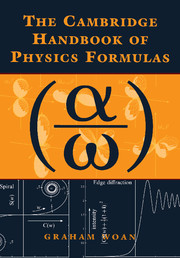1 - Units, constants, and conversions
Published online by Cambridge University Press: 05 September 2012
Summary
Introduction
The determination of physical constants and the definition of the units with which they are measured is a specialised and, to many, hidden branch of science.
A quantity with dimensions is one whose value must be expressed relative to one or more standard units. In the spirit of the rest of the book, this section is based around the International System of units (SI). This system uses seven base units (the number is somewhat arbitrary), such as the kilogram and the second, and defines their magnitudes in terms of physical laws or, in the case of the kilogram, an object called the “international prototype of the kilogram” kept in Paris. For convenience there are also a number of derived standards, such as the volt, which are defined as set combinations of the basic seven. Most of the physical observables we regard as being in some sense fundamental, such as the charge on an electron, are now known to a relative standard uncertainty, ur, of less than 10–7. The least well determined is the Newtonian constant of gravitation, presently standing at a rather lamentable ur of 1.5 – 10–3, and the best is the Rydberg constant (ur = 7.6 – 10–12). The dimensionless electron g-factor, representing twice the magnetic moment of an electron measured in Bohr magnetons, is now known to a relative uncertainty of only 4.1 – 10–12.
No matter which base units are used, physical quantities are expressed as the product of a numerical value and a unit. These two components have more-or-less equal standing and can be manipulated by following the usual rules of algebra.
- Type
- Chapter
- Information
- The Cambridge Handbook of Physics Formulas , pp. 3 - 18Publisher: Cambridge University PressPrint publication year: 2000



